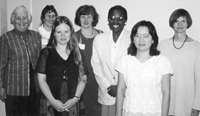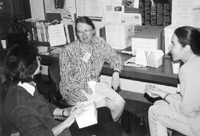What's in It for Women? What's in Them for Math?
November 1, 1999

Olga Taussky Todd Celebration organizers in attendance were (from left) current AWM president Jean Taylor (Rutgers University), Bettye Anne Case (Florida State University), former AWM president Sylvia Wiegand and Gail Ratcliff (University of Missouri), and Dianne O'Leary (University of Maryland). Photographs by R. Dimitric, courtesy of the Association for Women in Mathematics.
Philip J. Davis
In the spring of this year, my attention was drawn to a number of books and articles speculating on the possibility of considerable changes in mathematics over the next generation.
Also during the spring, an opportunity opened up for me to go to Berkeley, California, in my capacity as a columnist to attend a meeting of the Association for Women in Mathematics, held July 16-18, 1999, at the Mathematical Sciences Research Institute. My interaction with some of the participants, particularly the AWM officers, was strongly influenced by my spring reading. (My write-up on MSRI will appear in a later issue of SIAM News.)
Before going west, I sought advice from a woman friend who is a historian of mathematics and science as to what basic question I should be asking. Her answer was immediate:
"Ask the participants what women have gotten from mathematics and what mathematics has gotten from women, considering the present and looking toward the future."
My historian friend and I were both thinking in terms of long periods of time, fifty years at the very least. Her suggested conversational gambit was therefore very agreeable to me.
For those who do not know about AWM, its wide-ranging activities embrace lectures, workshops, travel grants, prizes, and mentoring. It also acts as an information service. For the past several years, AWM has held very successful workshops at SIAM annual meetings. The reader can check out AWM at www.awm-math.org.
The Berkeley meeting, billed as "The Olga Taussky Todd Celebration of Careers in Mathematics for Women," consisted of two interlaced parts: (1) talks about Olga Taussky Todd, her life and her mathematical career, and (2) invited talks and poster board presentations discussing what the speakers had accomplished, and how they had navigated as women an often rocky mathematical career road.
Some time ago (Vol. 29, No. 2, March 1996), SIAM News ran an obituary of Olga Taussky Todd (1906-1995), a woman who made major contributions to class field theory and matrix theory. In the course of a long mathematical life, Taussky Todd went from the University of Vienna, to G�ttingen, to Girton in Cambridge, to Bryn Mawr, to the University of London. At the beginning of World War II she went with her husband John Todd to Queens in Belfast, then back to London to do war work. After the war, she worked for a time at the National Bureau of Standards in Washington and finally, in 1957, moved to Caltech. Thus, she experienced considerable job instability in her earlier years, due in part to the war, and though the years in Pasadena were both stable and fruitful, the fact that for many years she was not granted full professorial rank at Caltech rankled.
Unified around the subject of women's mathematical careers, the program had talks that dealt with Olga Taussky Todd's training in Vienna, her subsequent experiences, what she worked on, who her students were, and more. She was set forth as a role model for the younger women in the audience and an inspiration for all.
Serving also as role models, a number of women currently employed as mathematicians in universities, industry, and government discussed what sort of work they were currently doing and how they got into it. Considerable advice was offered by the speakers and panelists (and elicited by questions from the audience) as how to succeed in "the career game" of mathematical chutes and ladders.
The panelists conveyed enthusiasm and optimism. The university women, like their male colleagues, seemed to buy right into the old saying that "real mathematicians prove theorems."

Plenary speakers included (from left) Cathleen Morawetz (Courant Institute), Helene Shapiro (Swarthmore College), Linda Petzold, Christa Binder (Technical University of Vienna), Fern Hunt (NIST), Lani Wu, and Lisa Goldberg (BARRA, Inc.).
I was pleasantly surprised by how much emphasis was given to applications: cryptography, investment finance, design for wireless communication, fluid theory, among others. Certainly the message to the younger attendees was loud and clear: A nonacademic postdoctoral life is eminently possible.
I was also struck by how little discussion there was on balancing a career, children, husband, and on the related "two-body problem." The opinions expressed were that these were private matters to be worked out individually, with few general precepts available. Ann Landers types did not come forward.
I went west in a historical frame of mind that was long range. As it turned out, my questions were not at all agreeable to my interviewees, who were concerned with the pressing and immediate problem of how to achieve equal rights for women in the mathematical field. The two questions suggested by my historian friend were either brushed off entirely or answered in a way that I was not looking for.
What had mathematics done for women? A former AWM officer answered that mathematics was simply wonderful; that she delighted in it, in learning it, teaching it, and creating new mathematics. It was the breath of life to her---similar to what it is for many men. Another of my interviewees answered that she had worked out the statistics of the financial support for women in collegiate sports, and had thereby won a court case (against Brown University, actually.)

More mentors in action. From far left, Margaret Wright (Bell Labs), Linda Petzold (UC Santa Barbara), and Lani Wu (Microsoft); each also gave a plenary talk at the Olga Taussky Todd Celebration.

In the AWM tradition, NIST mathematician Isabel Beichl (middle) serves as a mentor for Ruth Pfeiffer of the National Cancer Institute (left) and Lesley Ward of Harvey Mudd College.
As regards what women had done and would do in the future for mathematics, many answers seemed to be variations on: "Well? You've seen and heard what we've been up to; I suppose we will carry on along those lines." Closer to what I had in mind by way of a response was the hope expressed by one interviewee that women are better communicators than men and that they will change our ideas as to what is mathematically respectable.
As mentioned earlier, I had been thinking in large time units. History shows that over the centuries the character of mathematics has changed considerably. Changes experienced in recent centuries include the drive toward an unattainable absolute rigor, the drive toward increased abstraction, the development of logic and the total identification of mathematics with logic, not to mention the hundreds of special topics that have been born even as many others have died.
I tried to perform a historical "Gedankenexperiment" in my mind. How, I wondered, would the mathematics of the future change if men left the field and it were occupied almost exclusively by women? Was such a turnabout imaginable? Well, it didn't contravene any laws of physics I was familiar with. Perhaps I was extrapolating linearly from the common perception, backed up by some stats, that young, native-born American men are not opting for science and mathematics. These subjects are hard work, and there is not nearly enough money in them.
The approach of the millennium has elicited considerable speculation as to what the mathematics of the future might look like. Just more of the same or a substantial change in the mindset, in the explicit goals and in the hardly as yet formulated underlying aspirations? One might think, from reading most histories of mathematics written in the past two centuries, that the meta-themes of mathematics (if we can call them that) have remained constant since Euclid wrote his Elements. This impression derives from a vast intellectual cleansing that occurred after the French Enlightenment and that described the mathematical past as the precursor of an inevitable present.
In his general-interest book Good-bye, Descartes, Keith Devlin describes the difficulties of the relationship between natural language, logic, and rationality. These difficulties, Devlin asserts, cannot be overcome by traditional mathematics of the Cartesian variety, and he envisions the development of a "soft mathematics"---hardly in existence now---that
"will involve a mixture of mathematical reasoning, and the less mathematically formal kinds of reasoning used in the social sciences."
It is hard to believe that contemporary mathematicians would allow soft mathematics to be admitted into the corpus of "honest-to-God" mathematics.
On the other hand, the late mathematician/philosopher Gian-Carlo Rota, in his paper "Ten Remarks on Husserl and Phenomenology," came to an opinion not unlike Devlin's. After listing seven properties that phenomenologists believe are shared by mathematics (absolute truth; items, not objects; nonexistence; identity; placelessness; novelty; rigor), Rota went on to say:
"Is it true that mathematics is at present the only existing discipline that meets these requirements? Is it not conceivable that some day, other new, altogether different theoretical sciences might come into being that will share the same properties while being distinct from mathematics?"
Rota believed that a new Galilean revolution would come about to create an alternative, soft mathematics, that would establish theoretical laws through idealizations that run counter to common sense. Let me now return to the particular qualities that might be injected into mathematics by women.
Quite apart from discussions of equal rights and equal abilities, it seems to me that gender-related features are a lively possibility. I heard no discussion of this at the meeting, locked in as most mathematicians (whether men or women) are to traditional criteria and agendas.
If more woman were in mathematics and science (particularly in physics), according to Margaret Wertheim in her recent book Pythagoras' Trousers, they would create
"an environment in which one could pursue the quest for mathematical relationships in the world around us, but within a more human ethos. . . . Mathematical Man's problem is neither his math nor his maleness per se, but rather the pseudoreligious ideals and self-image with which he so easily becomes obsessed."
More women are now entering mathematics and science. It will take at least two generations to observe whether or not any of the foggy visions just described will materialize and what the particular contribution of women as women will have been.
Philip J. Davis, professor emeritus of applied mathematics at Brown University, is an independent writer, scholar, and lecturer. He lives in Providence, Rhode Island.

